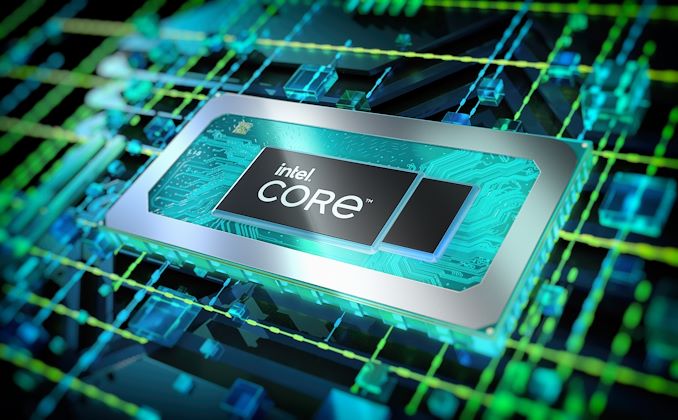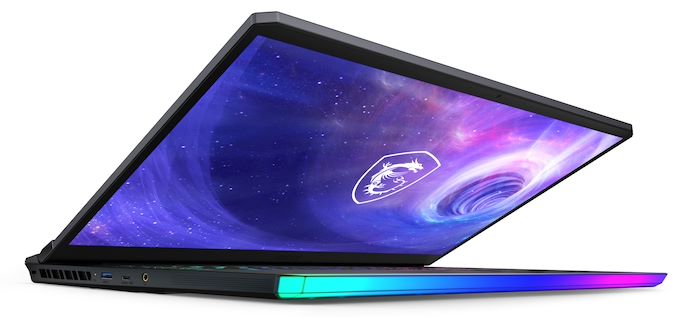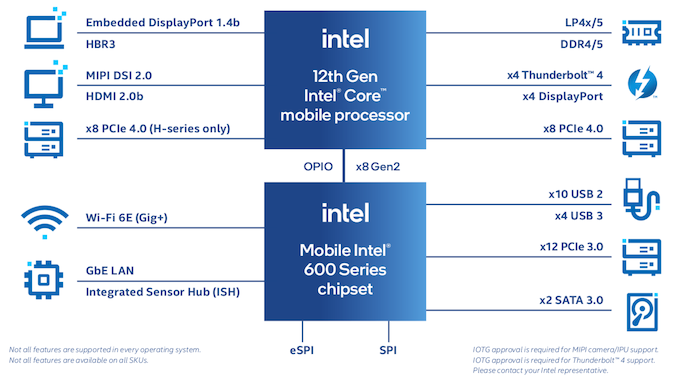Intel Alder Lake-H Core i9-12900HK Review: MSI's Raider GE76 Goes Hybrid
by Brett Howse on January 25, 2022 9:00 AM EST- Posted in
- CPUs
- Intel
- MSI
- Laptops
- Alder Lake
- GE76 Raider
- 12th Gen Core
- Alder Lake-H
_photo02_cr_678x452.jpg)
At CES this year, Intel officially announced its expanded Alder Lake processor lineup, including the performance-laptop focused H-Series chips, which traditionally fit in the 45-Watt range. For the last several processor generations, Intel has started their roll-outs with the low-power laptop parts, and then expanded the range up to and including desktop processors; but for Alder Lake they have flipped this on its head. Instead, Intel first launched desktop processors, such as the Core i9-12900K, and then moved down the range, with the performance notebook processors coming second, and the low-power processors coming later.
| Intel 12th Gen Core Alder Lake-H | |||||||
| AnandTech | Cores P+E |
E-Core Base |
E-Core Turbo |
P-Core Base |
P-Core Turbo |
Base W |
Turbo W |
| i9-12900HK | 6+8 | 1800 | 3800 | 2500 | 5000 | 45 | 115 |
| i9-12900H | 6+8 | 1800 | 3800 | 2500 | 5000 | 45 | 115 |
| i7-12800H | 6+8 | 1800 | 3700 | 2400 | 4800 | 45 | 115 |
| i7-12700H | 6+8 | 1700 | 3500 | 2300 | 4700 | 45 | 115 |
| i7-12650H | 6+4 | 1700 | 3500 | 2300 | 4700 | 45 | 115 |
| i5-12600H | 4+8 | 2000 | 3300 | 2700 | 4500 | 45 | 95 |
| i5-12500H | 4+8 | 1800 | 3300 | 2500 | 4500 | 45 | 95 |
| i5-12450H | 4+4 | 1500 | 3300 | 2000 | 4400 | 45 | 95 |
Today, we finally get to take a look at the 12th generation H-Series processors and see how they stack up to not only Intel’s previous 11th generation Tiger Lake platform, but also AMD’s Ryzen 5000 Mobile series. If you’ve not yet taken a look at the initial Alder Lake desktop processor review, definitely check that out since Alder Lake is a big departure from Intel’s traditional CPU design. Featuring a new hybrid CPU design with performance (P-cores) and efficiency cores (E-cores), the new design is more characteristic of what you would see in a smartphone platform, except Intel’s efficiency cores offer almost Skylake levels of performance and should not be disregarded.
Combined with Windows 11, Intel is hoping to improve multi-tasking performance with not only more cores, but also with Windows 11 being able to park jobs that are not in the foreground on the efficiency cores, leaving the performance cores available for the user to avoid system responsiveness problems even when the system is heavily loaded.
The Test System – MSI Raider GE76
Intel is putting its best foot forward, as expected, by supplying the MSI Raider GE76 system for performance testing. This 17-inch desktop-replacement machine is nearly always at the top of all notebook performance comparisons, and for 2022, MSI has kept the chassis the same, save for adding in Alder Lake as well as the latest NVIDIA RTX 3080 Ti Laptop GPU. We recently reviewed the Tiger Lake version of this notebook so if you want to learn more about the device, please check that review out. The Tiger Lake version was the fastest notebook we had ever tested, so expectations are high with the new Alder Lake refresh. We will be covering some of the same aspects here as well.
And for those that follow MSI, be aware that for 2022 they are moving the laptop name ahead of the model number, so it is now the Raider GE76, whereas last year it was the GE76 Raider.
| MSI Raider GE76 Alder Lake | |||||
| Component | As Tested | ||||
| CPU | Intel Core i9-12900HK 6 x P-Core, 8 x E-Core, 20 Threads 85 W TDP |
||||
| GPU | NVIDIA RTX 3080 Ti for Laptops 7424 CUDA Cores 16GB GDDR6 (16Gbps) |
||||
| RAM | 2 x 16GB DDR5-4800 | ||||
| Display | 17.3-inch 1920x1080 360 Hz | ||||
| Storage | 2 x Samsung PM9A1 1 TB NVMe PCIe 4.0 | ||||
| Networking | Killer AX1675 Wi-Fi 6E Killer E3100G Ethernet |
||||
| I/O | 1 x Thunderbolt 4 3 x USB 3.2 Gen 2 Type-A 1 x USB 3.2 Gen2 Type-C 1 x HDMI 2.1 1 x Mini DisplayPort 1.4 SD Card Reader Headset jack |
||||
| Keyboard | Steelseries per-key RGB Anti-Ghost | ||||
| Audio/Video | 1080p Webcam 2 x 2W + 2 x 1W Speakers |
||||
| Battery | 99.9 Wh Battery 330 W AC Adapter |
||||
| Dimensions | 15.63 x 11.18 x 1.02 inches | ||||
| Weight | 2.9 kg / 6.9 lbs | ||||
| Price (USD) | $3600 USD with single SSD | ||||
MSI checks all the boxes for 2022. Featuring the Core i9-12900HK, 32 GB of DDR5-4800 memory, the newest NVIDIA RTX 3080 Ti Laptop GPU, and not one but two Samsung PM9A1 1 TB NVMe PCIe 4.0 drives. MSI has improved their cooling solution for 2022 with a new Phase Change thermal pad as well, allowing the system to wick heat away from the hot components into the cooling system with even more efficiency.
The Core i9-12900HK Processor
At the top of the Alder Lake laptop product stack is the Core i9-12900HK processor. It features six of the new Golden Cove P-cores and eight of the new Gracemont E-cores. The P-Core can turbo up to 5 GHz, while the E-Core caps out at 3.8 GHz. The processor has a nominal TDP of 45 Watts – though in the case of our Raider, the TDP appears to be set closer to 75 Watts out of the box – with a peak turbo draw of up to 115 Watts. It offers up to eight lanes of PCIe 4.0 for graphics and two sets of four PCIe 4.0 lanes for storage, along with an additional twelve PCIe 3.0 lanes.
One of the big changes for Alder Lake-H is that Intel has taken a page from the design for their U/Y/P series chips and moved the formerly separate PCH on to the processor package itself. This essentially reduces Alder Lake-H to a single package solution, as like its other mobile brethren, no external silicon is required to provide necessary I/O functionality. By reducing ADL-H to a single package, this will allow for smaller form factor designs, as well as reducing the footprint that needs to be cooled.
The new processor can support up to 64 GB of memory, and supports DDR5-4800, LPDDR5-5200, DDR4-3200, and LPDDR4-4267. There are a plethora of PCIe lanes available with eight PCIe 4.0 lanes for graphics, two sets of four PCIe 4.0 lanes for storage, and an additional twelve PCIe 3.0 lanes. It can't quite match a desktop processor and chipset, and the laptop processors do not have support for PCIe 5.0 yet unlike their desktop counterparts, but it is still a significant amount of expansion available. There is also support for up to four Thunderbolt 4 ports for external I/O.
On the graphics front, the Core i9-12900HK offers Intel Iris Xe graphics with 96 Execution Units on tap with a peak GPU frequency of 1.45 GHz. This is a big step up in terms of integrated graphics from the Tiger Lake H-Series, which only provided 32 Execution Units of Intel UHD graphics. Laptop buyers will be unlikely to find the H-Series where it is not paired with a dedicated graphics card, but it is nice to see that the latest Alder Lake lineup does get access to the top-tier graphics regardless.















153 Comments
View All Comments
soloracerx - Tuesday, January 25, 2022 - link
NewEgg just put up the pre-orders today for the MSI line 12th gen lappys. Staggered release from Feb through April. The one reviewed here will be available 3/28/22 for $4199. https://www.newegg.com/p/pl?d=12th+gen+laptopmabellon - Tuesday, January 25, 2022 - link
“The new Alder Lake system could only average 83% of its original frames per second, because that task was deprioritized by Thread Director to free up additional resources for the foreground jobs.”Foreground and background detection is provided by the OS. The CPU alone has no way to identify which threads are rendering on screen, the OS and window management tracking is responsible. This window tracking, and more, are critical for hybrid scheduling, favored core scheduling, etc. Https://docs.microsoft.com/en-us/windows/win32/procthread/quality-of-service
If you want to test Thread Director you need to test workloads with multiple concurrent workload classifications by Thread Director. A complex workload (or multiple concurrent workloads) with different thread execution (I.e. some AVX, some not). For example, if you have two on-screen workloads (I.e. both prefer performance), but there are more concurrent workload threads to schedule than there are P-Cores, which subset of those threads will get the most performance out of the limited set of P-Cores?Homogenous workloads where all threads are roughly equivalent and running the same instruction mix are unlikely to have much impact (e.g. Cinebench, Handbrake). Workloads that fit entirely on P-Cores are unlikely to have much impact as there is no overflow to E-cores.
Another alternative would be if a particular workload classification was inverted versus the norm. For example, normally one would expect E-cores to be the most efficient. On a laptop you might want background services and apps scheduled to the most efficient cores for battery life. But what if the workload running happens to heavily exercise instructions that are actually more efficient to run on P-cores?
Those are some examples of how Thread Director plays a role.
kenansadhu - Thursday, January 27, 2022 - link
Will it be where the AMD's design win out? Because there wouldn't be any risk for the user of any OS or scheduler's mistake (since all cores are the same).Da W - Tuesday, January 25, 2022 - link
I remember back in the days when AMD GPU was beating NVIdia but with 50 watt more power draw, they were discarded as crap!How things change. Wattage does not seem to matter anymore.
Calin - Wednesday, January 26, 2022 - link
I chose nVidia because I didn't had a PCI-E power cable (or the wattage). At roughly similar price and performance, AMD broke the 75W limit and nVidia didn't.With processors already installed in systems, the equation changes a bit - you can still get the performance, at a lower battery life.
Spunjji - Thursday, January 27, 2022 - link
Generally speaking, you can assume that watts are important when AMD draw more of them; not so much when Intel or Nvidia draw more and win.TheinsanegamerN - Friday, January 28, 2022 - link
Nobody disregarded AMD's hawaii GPUs for pulling more power, tech media was singing their praises from every rooftop.They slammed the 390x for being just a rebranded 290x that drew even more power but couldnt keep up with nvidia's high end.
But context is the enemy of the fanboi.
BillBear - Tuesday, January 25, 2022 - link
You guys really need to start posting performance numbers when the laptop is unplugged, now that power draw figures have become so ridiculous that laptops immediately have to throttle down when unplugged.TekCheck - Tuesday, January 25, 2022 - link
Benchamark tech-tubers and tech website should follow Anandtech's practice and start publishing performance+power benchmarks for laptops, to give us better context behind high bars in any test. This is less important for desktops, but as laptops are usually portable devices, it is paramount that we know the power behind performance.If 12900HK is winning in any bars, say 20% over 6900HX, we need to know at which power level. Is it at 45W? At 60W? At 115W? If the win is at high wattage only, users will have a wrong impression that such CPU has "better" performance, which is untrue without knowing the power needed for such performance.
Brett Howse - Tuesday, January 25, 2022 - link
Mentioned this in the review. The AMD 5900HX system also draws the same power at load.